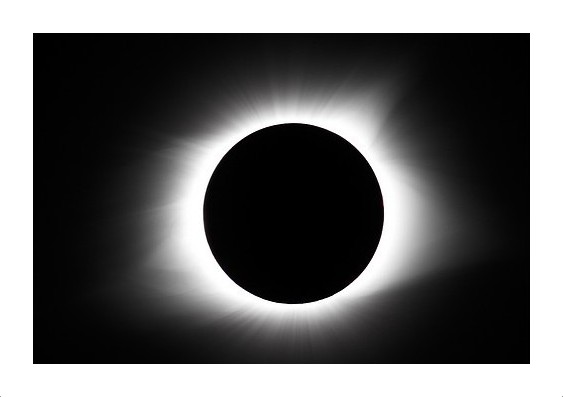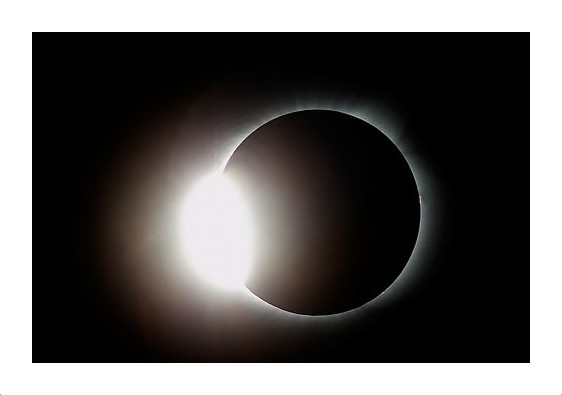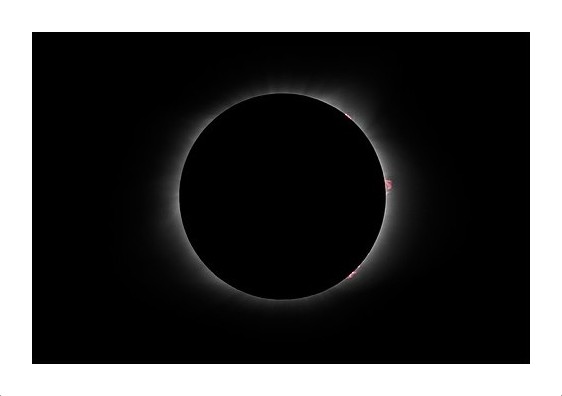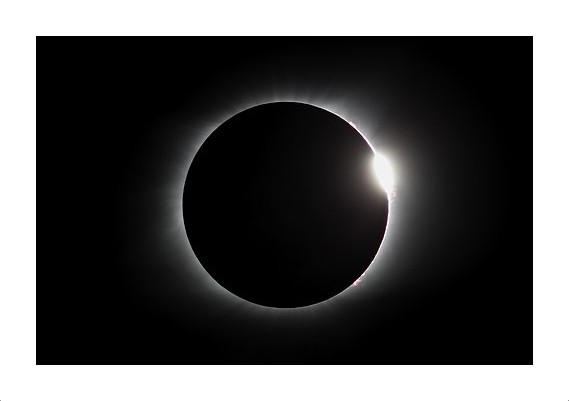The Peregrine Vol 17, No 1, January/February 2018
Additional Article
Great American Eclipse of 2017

A Different Kind of Chase: Not for Birds This Time
I had gone down the rabbit hole. That's how my college roommate and friend of more than 20 years put it, anyway. I had planned for every detail, every conceivable outcome. We were willing to drive ourselves more than a thousand miles, one way, for the spectacle. If cell coverage was spotty or lost altogether, I had procured hard copies of DeLorme atlases of three different states to navigate the old fashioned way. I had learned more than I had ever expected to know about things called HRRR, GFS, NAM, and ECMWF - those are the tools and forecasting models that every local and national weatherman in the country relies on for your five-day outlook. We packed the car with three days of food, pillows and blankets, telescope, camera, binoculars, and yes, even a few empty gas cans, just in case. The chase was on.
Sounds familiar, doesn't it? Okay, maybe not the gas cans, but everything else? Were we chasing a rare bird, some errant ABA Code 5 that crashed out in some farmer's pond in North Dakota? Or perhaps, what with our "emergency" preparations (gas cans), was a hurricane about to bring a boatload of pelagics and state lifers onshore?
No, we weren't chasing birds, not this time. This time, we were chasing something altogether different, something that was guaranteed not to fly away five minutes before we got there. We were after the Great American Eclipse of 2017.
It's said that to witness a total solar eclipse is akin to a religious experience. People I had talked to who had seen one before put it this way: it's not difficult to describe what happens during a total solar eclipse, but it's not really possible to describe the experience.
As for what happens: in the moments leading up to totality, the sunlight starts to dim, and the daylight slowly turns almost sickly-looking, as if someone cast a giant tinted windshield across the heavens. Yet up to the moment of totality itself, the sun is still too bright to look at with the naked eye, even when it's 99% blocked by the moon. Then it happens, and the moon's umbra (shadow) passes directly over you, and suddenly the sun is replaced by a giant black hole in the sky.
It gets dark - how dark depends on how close you are to the center of the shadow, and how wide the shadow itself is - but it does get dark, like a deep twilight long after sunset, and the brighter stars and planets suddenly become visible in the middle of the day. Confused birds stop singing and fly to roost, and bugs stop their chatter too. The temperature drops, maybe more than ten degrees. The sun's corona reveals itself, like a great hoary mane around the edges of the black face of the moon. If you have a telescope, you can now get close up views of solar prominences - huge arches of gas blazing out from the surface of the sun and past the edge of the moon, big enough to swallow the earth whole three times over again. And then just as suddenly as it started, the false nighttime ends, and daylight returns.
Whether the experience is religious or spiritual, or merely marvelous, awe-inspiring, unforgettable, and humbling, or maybe just jaw-dropping, the point is that the only way to really understand what it's like is to experience it for oneself.
My wife Kristin and I had been planning to see this thing for over five years. The appointed date was August 21, 2017. The appointed place was, well, really a lot of places between Oregon and South Carolina.
Solar eclipses occur, of course, when the moon moves in line between the sun and the earth, and casts some or all of its shadow onto the earth's surface. Theoretically, this could happen every month during the new moon, but because the moon's orbit around the earth is not in the same plane as the earth's orbit around the sun, the moon's shadow does not fall on the earth at every new moon. Instead it happens on average about once or twice per year. But even though a solar eclipse is more or less a yearly thing, total eclipses are only a subset of all solar eclipses, occurring only when the moon is completely in line between the earth and sun and is close enough to the earth, in its not-quite-circular-orbit, to be large enough in the sky to completely block the sun when viewed from the earth. This happens more like once every year and a half.

Adding to the rarity of seeing one is the fact that the moon's shadow does not cover the entire surface of the earth during a total eclipse. Very far from it, in fact. During eclipses that are not near the earth's poles, like the 2017 eclipse, the shadow traces out only a long sliver of ground (the "ground track"), a narrow band that may be about 60-150 miles wide, and perhaps 6000 miles long, as the shadow races across the surface of the earth. So, during some part of its transit, the shadow falls on somewhere between, say, 360,000 and 900,000 square miles of the earth's surface. The total surface area of the earth is 196.9 million square miles - meaning that the chance that the shadow falls on any one spot on the earth is somewhere between about 0.2% and 0.45%, depending on the nature of the eclipse. From the perspective of an earthbound observer at any point outside that tiny sliver of ground track, the eclipse will only be partial. And of course the eclipse isn't visible at all, not even partially, to anyone on the half of the globe that's shrouded by nighttime during the event.
Another difficulty in observing total eclipses is that they don't last very long at any one spot within the ground track. Totality at a given spot on the earth's surface lasts just 2 to 7 minutes, again depending on the nature the eclipse. So: in order to see a total solar eclipse, you have to be within the narrow band of the eclipse (on the order of ~100 miles wide), at exactly the right time (2-7 minute window), on the one right day out of about 500. Add all that up, and it turns out that a total solar eclipse will pass within 500 miles of your house only two or three times in your lifetime. Chances that one will pass directly over your house are much less than once in your lifetime. In fact, the next time the moon will cast its shadow directly onto the city of Pittsburgh will be September 12, 2444. If you're still reading this then, be advised that totality will start at 12:47 PM EDT.
Oh, and one last thing: even if you're in the path of totality on the right day at the right time, the sky has to be free of clouds where you are too, otherwise you'll just see, well, dark clouds.
So, solar eclipses are rare, not frequently seen nearby, and are easily obscured by clouds. The Great American Eclipse of 2017 became so-known because it was the first total solar eclipse with a ground track that would touch some part of the continental United States since 1979, when one crossed through the northwestern corner of the Lower 48. Put another way, the 2017 eclipse was the first time in two generations that a total eclipse could be seen from somewhere in the mainland United States, and the first time that one would cross the entire Continental U.S., all the way from the Pacific to the Atlantic, since 1918. Moreover, because it would trace out a coast-to-coast ground track, it would pass through no fewer than 14 states and directly over the homes about 12.2 million people, and within 400 miles of the homes of more than 150 million others, most of whom own cars. Several million of these, as well as people flying in from around the world, would drive to a spot within the zone of totality on the day of the eclipse. Kristin and I would be among them.
On August 21, a Monday, the shadow would be visible - in this case for about 2 minutes and 40 seconds - from many areas in Oregon, Idaho, Wyoming, and Nebraska in the west, and Missouri, Kentucky, Tennessee, and South Carolina in the east, so finding somewhere that totality would be visible was not difficult at all. The trick to this chase would be twofold: which areas were least likely to have cloud cover on August 21, and which areas would be the least overwhelmed with crowds, cars, and traffic gridlock. And here weather prediction takes an even more absurd turn: we all know that the weatherman is lucky to get the five-day forecast right even a quarter of the time. But we weren't looking for a high temperature or a prediction of the wind direction. We wanted to know perhaps the hardest thing to predict of all: cloud cover. How cloudy is "partly cloudy", exactly? We had pored over charts and historical averages by year, and had finally landed on a general strategy: on the Friday before the eclipse, we'd start driving toward Nebraska. It was the closest place to Pittsburgh with a high probability of a clear sky in August (eastern Oregon was best of all, but over 2500 miles away), and it was least likely to suffer from the soul-crushing gridlock of 500,000 extra cars on the road. If the forecast for Nebraska looked dicey, we'd scramble at the last minute for who knows where.

It didn't take long to make a decision, and by Friday night it already seemed as if Nebraska wouldn't be worth the effort. The cloud cover models, especially GFS and NAM (I had long ago bypassed the weather forecasters and gone straight to the sources myself) were showing a 50/50 proposition of clear skies in Nebraska and Missouri. We ended up delaying our departure until early Saturday morning, and headed to Tennessee instead, which had a much more favorable forecast, yet still nothing approaching guarantee. Traffic would be much worse there too, and being in the humid southeast, it wouldn't take much for a few afternoon clouds to pop up on an otherwise "mostly sunny" day to ruin the view. We'd just have to take our chances, and be in a position to be mobile on the morning of the event.
By the time we arrived in Tennessee early on Sunday morning, we were joining what were already thousands of people from all across the eastern U.S. and indeed the world. They included a few familiar faces too: fellow 3RBC members Dave Wilton and Shannon Thompson had also been planning to see the eclipse for some time, and had also routed to Kentucky and Tennessee based on the forecast.
Most people were headed to small towns or larger cities along the eclipse path, where viewing parties and events had been planned by local chambers of commerce probably for as long as Kristin and I had been planning, too. But we preferred to view the eclipse away from these crowds, so on Sunday afternoon, the day before the eclipse, we scouted over a hundred miles of country roads along the so-called "centerline" of the track the shadow would take the next day through southern Kentucky and north-central Tennessee. We ultimately chose a non-descript field full of soybeans on a modest plateau in northern Tennessee, directly on the centerline, where totality would last the longest and the darkness would descend the deepest. Dave and Shannon had also arrived in the area by then, and opted for a small cemetery that Kristin and I had found in southwestern Kentucky during our scouting that seemed to be well out of the way of the crowds.
By late Sunday afternoon, Eclipse Madness was well underway. The forecast was looking pretty good for us, and last minute visitors were now pouring into Kentucky and Tennessee by the thousands, with thousands more to arrive the next day, Eclipse Day. The cellular phone network was already breaking down Sunday afternoon, and getting a mobile data connection was out of the question. Our DeLormes came very much in handy, as did a one-hour pit stop at a McDonald's in Nowhereville, KY (not a real town name) where we ordered nothing more than a free wifi connection and an update on the latest NAM and HRRR model runs. The traffic situation in Tennessee was deteriorating, exacerbated by the poor cloud forecast in Missouri and Illinois for Monday, where thousands of visitors had converged on St. Louis and other cities and towns nearby to use as a base of operations for eclipse chasing. Now those people were scrambling east to Kentucky and Tennessee and the promise of a better chance at sunny skies. My college roommate Pat, also chasing the eclipse along with two of his kids in St. Louis on Sunday, was among them, and they too were now headed to Tennessee to crash on our hotel room floor. I suppose he was now down the rabbit hole too. What few hotel rooms were still available in our area were going at the last minute for $500 or more, and were finding buyers.
But after all that, Eclipse Day, thankfully, went off without a hitch. We beat the traffic out of town where we were staying and returned to our soybean field, and enjoyed the eclipse with Pat and his kids in complete solitude. I had all the equipment - my normally bird-oriented spotting scope was fitted with a solar filter, and ditto for my big camera. Pat supplied eclipse glasses for all of us. The soybean farmer stopped by to size us up with a curious look, and asked how we found this little spot, but cheerfully left us to ourselves.

I won't really try to describe the experience of seeing it - again, you really can't - except to say that all the madness, all the crazy planning, all the poring over maps and cloud models and gas station locations, all the days of driving, the horrendous traffic we still had to face getting home, were all worth it, a hundred times over again. I got some pictures, but not too many. Totality would last only 2 minutes and 40 seconds this time, and I didn't want to spend all of it fiddling around with a camera. A total eclipse is total sensory experience, and even the best pictures do not do it justice: the remarkable and unforgettable sight of the sun's corona, the strangely symmetrical twilight on all horizons, the sudden silence, the chill in the air. Totality was everything it's cracked up to be, and all too short.
Bird behavior during the eclipse was very interesting, too. Of course, we've all heard the old birding adage, "you're never not birding." Once you have the birding bug, you can never not notice the birds around you, no matter where you are or what you're doing. Even if you're just walking from your car into a grocery store, you register the crows that are cavorting over by the dumpster.
This holds true even during a total eclipse. For me as a birder, one of the most fascinating aspects of the eclipse was to see that, yes indeed, birds really do go to roost as the shadow passes over. With about five minutes to go before totality, we had small groups of Horned Larks flying over, agitated and calling repeatedly, only to disappear and shut up during totality. All the cricket and other insect noise suddenly ceased, as did all bird calls, and a deep and penetrating silence fell over the landscape.
At the cemetery in Kentucky, which was adjacent to a small pond, Shannon and Dave observed the shorebirds that had been there suddenly get alert and fly off as the sun disappeared, and after totality had passed and daylight returned, geese started flying in, having apparently left whatever field they had been feeding in to fly to the pond to roost. How confused they must have been to find that it was bright daylight again at their roost pond when they got there!
Back up in our soybean field, the silence still wasn't broken for a few moments after totality passed, when finally a Summer Tanager issued forth with a few hesitant pik-i-tuks. It was quite a magical moment. If you want to see my whole eclipse checklist, it's here: Checklist.
Fortunately, for those who could not make the trek to see the Great American Eclipse of 2017, or who didn't think it would be worth the effort, you won't have to wait another two generations for the next one to cross American soil. The Next Great American Eclipse is just seven years away, when, on April 8, 2024, another path of totality will cross through the U.S. from Texas to upstate New York and Maine and into the Canadian Maritimes.
The zone of totality will pass remarkably close to Pittsburgh, with the moon casting its shadow on northwestern Pennsylvania everywhere from the Lake Erie shore south to Warren, Titusville, and Hermitage.
As for Kristin and me, now that we've seen one, the next one will never be enough, and seven years is too long to wait. Southern South America, specifically Chile and Argentina, will be treated to back-to-back total solar eclipses in 2019 and 2020...
See full-sized versions of Geoff's spectacular eclipse photographs in his Flickr album Total Solar Eclipse 2017.






